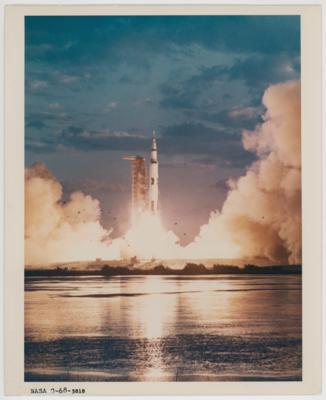NASA (Apollo 4)
The historic liftoff of the first Saturn V rocket from Pad 39A at the Kennedy Space Center, 9 November 1967
Vintage chromogenic print on fiber-based paper, printed 1967-1968, numbered "NASA G-68-5818" in black in bottom margin, with numbered NASA caption (NASA Goddard SFC) and "A KODAK PAPER" watermark on verso, 25,4 x 20,3 cm, slightly bumped in the lower left margin
Apollo 4 was the first of the “big shots,” the test launch of the colossal three-stage Saturn V space vehicle that would take men to the Moon, and a critical success for NASA.
The mission was the first to lift off from Launch Complex 39, specially constructed for the giant Moon rocket, and represented a major milestone in NASA’s efforts to land humans on the Moon.
On the morning of November 9, 1967, the ambitious effort to develop the Saturn V was achieved. At 7:00 a.m. EST, NASA’s Kennedy Space Center experienced the roar of a rocket. The rocket’s power of 7.5 million pounds of thrust reached the Launch Control Center (LCC), Press Site and spectators, all three miles away, shocking even veteran launch viewers and creating one of the loudest-ever human-made sounds.
“Go, baby, go,” Wernher von Braun, the chief architect of the Saturn V rocket, was heard to shout. (Poole, p. 85)
Read more: www.nasa.gov/feature/apollo-4-was-first-ever-launch-from-nasas-kennedy-space-center
[NASA caption]
The National Aeronautics and Space Administration launched the first flight test of the Apollo/Saturn V space vehicle at 7:00 a.m., EST, November 9, 1967 from Complex 39A, Kennedy Space Center, Fla. At liftoff the 363-foot launch vehicle weighed 6,220,025 pounds. The first-stage engines produced 7,500,000 pounds of thrust and burnt 15 tons of fuel per second. The Apollo 4 flight plan calls for the Saturn V to place the Apollo spacecraft and the launch vehicle third (S-IVS) stage into a 117 statute mile circular orbit. After completing to orbits, the third stage will re-ignite to place the Apollo spacecraft into orbit and the service module propulsion system will be fired to raise the spacecraft's apogee to 11,400 miles. A second service propulsion engine firing during descent from apogee will boost the velocity to about 25,000 miles per hour. Protected by its heat shield, the command module will reenter the atmosphere, land and be recovered in the Pacific Ocean about 622 miles northwest of Hawaii
Literature:
TIME, 17 November 1967, pp. 84-85 (variant).
Expert: Mag. Eva Königseder
 Mag. Eva Königseder
Mag. Eva Königseder
+43-1-515 60-421
eva.koenigseder@dorotheum.at
27.09.2023 - 14:58
- Dosažená cena: **
-
EUR 1.820,-
- Odhadní cena:
-
EUR 1.000,- do EUR 1.500,-
- Vyvolávací cena:
-
EUR 100,-
NASA (Apollo 4)
The historic liftoff of the first Saturn V rocket from Pad 39A at the Kennedy Space Center, 9 November 1967
Vintage chromogenic print on fiber-based paper, printed 1967-1968, numbered "NASA G-68-5818" in black in bottom margin, with numbered NASA caption (NASA Goddard SFC) and "A KODAK PAPER" watermark on verso, 25,4 x 20,3 cm, slightly bumped in the lower left margin
Apollo 4 was the first of the “big shots,” the test launch of the colossal three-stage Saturn V space vehicle that would take men to the Moon, and a critical success for NASA.
The mission was the first to lift off from Launch Complex 39, specially constructed for the giant Moon rocket, and represented a major milestone in NASA’s efforts to land humans on the Moon.
On the morning of November 9, 1967, the ambitious effort to develop the Saturn V was achieved. At 7:00 a.m. EST, NASA’s Kennedy Space Center experienced the roar of a rocket. The rocket’s power of 7.5 million pounds of thrust reached the Launch Control Center (LCC), Press Site and spectators, all three miles away, shocking even veteran launch viewers and creating one of the loudest-ever human-made sounds.
“Go, baby, go,” Wernher von Braun, the chief architect of the Saturn V rocket, was heard to shout. (Poole, p. 85)
Read more: www.nasa.gov/feature/apollo-4-was-first-ever-launch-from-nasas-kennedy-space-center
[NASA caption]
The National Aeronautics and Space Administration launched the first flight test of the Apollo/Saturn V space vehicle at 7:00 a.m., EST, November 9, 1967 from Complex 39A, Kennedy Space Center, Fla. At liftoff the 363-foot launch vehicle weighed 6,220,025 pounds. The first-stage engines produced 7,500,000 pounds of thrust and burnt 15 tons of fuel per second. The Apollo 4 flight plan calls for the Saturn V to place the Apollo spacecraft and the launch vehicle third (S-IVS) stage into a 117 statute mile circular orbit. After completing to orbits, the third stage will re-ignite to place the Apollo spacecraft into orbit and the service module propulsion system will be fired to raise the spacecraft's apogee to 11,400 miles. A second service propulsion engine firing during descent from apogee will boost the velocity to about 25,000 miles per hour. Protected by its heat shield, the command module will reenter the atmosphere, land and be recovered in the Pacific Ocean about 622 miles northwest of Hawaii
Literature:
TIME, 17 November 1967, pp. 84-85 (variant).
Expert: Mag. Eva Königseder
 Mag. Eva Königseder
Mag. Eva Königseder
+43-1-515 60-421
eva.koenigseder@dorotheum.at
|
Horká linka kupujících
Po-Pá: 10.00 - 17.00
kundendienst@dorotheum.at +43 1 515 60 200 |
| Aukce: | The Beauty of Space - Iconic Photographs of Early NASA Missions |
| Typ aukce: | Online aukce |
| Datum: | 27.09.2023 - 14:58 |
| Místo konání aukce: | Wien | Palais Dorotheum |
| Prohlídka: | Online |
** Kupní cena vč. poplatku kupujícího a DPH
Není již možné podávat příkazy ke koupi přes internet. Aukce se právě připravuje resp. byla již uskutečněna.
Všechny objekty umělce

